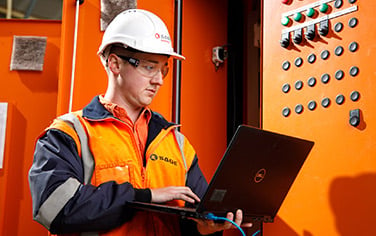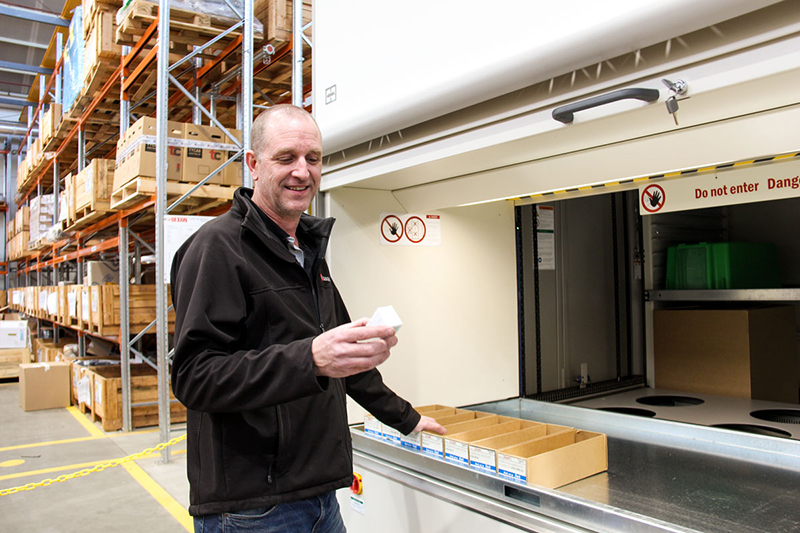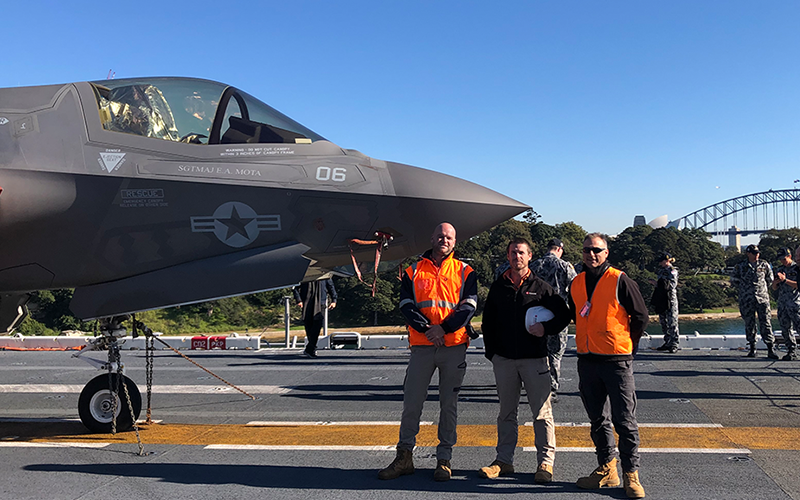What does an Industry 4.0 manufacturer look like?
SAGE Automation, Published: December 16, 2019 - Updated: March 13, 2020 (9 min read)
While there has always been innovation in the defence industry, the race is on for their supply chain partners to adopt Industry 4.0 technologies.
In a previous blog, we highlighted three key ways that Industry 4.0 initiatives can give advanced manufacturers an edge in the defence supply chain.
To help more defence primes to identify an advanced manufacturer it would be beneficial to partner with, we sat down with SAGE Automation’s General Manager for Defence, Paul Johnson, to gain some insight.

For those who may be unsure, can you explain what an Industry 4.0 defence manufacturer looks like?
As you can imagine, there can be a lot of differences in size and capability of manufacturers supplying to defence.
If we’re talking about SMEs, these tend to be smaller manufacturers with niche capabilities. They may have just one key product or service that they offer — but that may be highly sought after for use within the defence supply chain.
When it comes to larger manufacturers supplying to the defence supply chain, they may have a range of capabilities to suit multiple project needs within defence. In many cases, they are developing products or services for multiple customers or industries, not just defence.
Regardless of whether they are large or small, they are manufacturers who have invested in technology and process improvement initiatives, have streamlined systems and processes to create a step change in their manufacturing capabilities.
For example, SAGE has gone from being a backyard workshop to a manufacturing centre by using industry 4.0 initiatives; such as digital twin technology, automated manufacturing machines and automated storage. These initiatives enable quality, repeatability and throughput improvements to create a step change in capability.
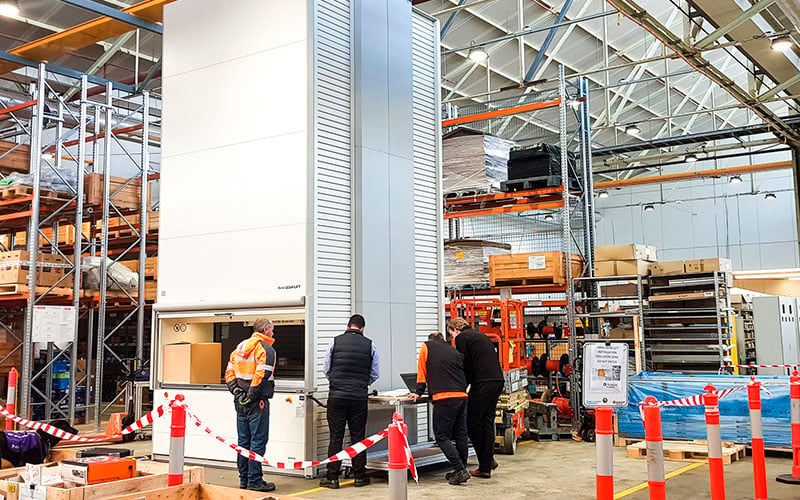
SAGE Automation's automatic lean lift is one example of an automated storage solution, capable of holding
consignment stock for SAGE's panels, while helping to reduce overall cost
What do you think are the key advantages for defence primes who choose to work with advanced manufacturers?
There can be a lot of advantages across all areas of the supply chain because improvements can be made in multiple stages of development.
At a high-level, these improvements tend to fall into the following areas:
• Improved speed — that can be in the development stage or in terms of speed to market.
• Collaboration — digital designs make collaborating within the supply chain much easier, so there is opportunity to respond faster or, in some circumstances, in real-time.
• Research and development — the ability to carry out research and develop in a digital environment has massive cost-saving potential.
• Agility — it is an advantage to be able to quickly change the way manufacturing is done without compromising quality or delivery windows.
The Industry 4.0 benefits for defence have been highlighted in one of our previous blogs, as we see increasing applications of this technology in the defence supply chain.
Can you tell us a little about some of the solutions we are seeing with Industry 4.0 in defence applications?
In manufacturing, we’re seeing a range of Industry 4.0 initiatives that are already shaking up the supply chain.
One of the most talked-about is the digital shipyard.
A digital shipyard uses Industry 4.0 technologies such as 3D modelling, digital twin, the Internet of Things and additive manufacturing in production to integrate the data and processes from all stages of the build. On top of that, the build incorporates intelligent systems to enable the monitoring and performance of the ship and its systems once it is commissioned.
The benefit of something like a digital shipyard is there is a single source of truth in the design phase, so the design can be easily replicated. Configuration management has always been a challenge for the defence supply chain, and digital models help to resolve this because we end up with only one version of the design. With digital ship designs, through-life-support is also easier because everything is digitised and the same across each ship, making building, maintenance and upgrades more efficient.
This type of technology isn’t just for shipbuilding though, it provides efficiencies for all kinds of projects.
VIDEO: General Manager of Defence Paul Johnson explains SAGE Automation's approach to Industry 4.0 transformation
We’ll also see solutions such as collaborative robots (cobots) more in defence applications as well. The investment might be out of reach for smaller manufacturers now, but cobots can be a good solution to manage labour shortages.
Another big opportunity is in visualisation and augmented reality (AR) as part of a workflow. There is a lot happening in terms of development and manufacturing already. We can expect to see more visualisation to deliver training and in-field support for technical repairs or fault-finding. Imagine being able to connect engineers and designers directly with someone carrying out maintenance on a ship or piece of equipment.
What do you believe are some of the key challenges facing manufacturers involved in the defence sector?
The long procurement times that are common with defence contracts can be challenging, particularly for smaller manufacturers. You have to remember that most companies are part of the defence industry supply chain — they are supplying or providing a service to defence primes, rather than working with Defence directly.
SMEs need to be able to demonstrate that they are capable of sustaining operations and long-term growth because this is necessary in the defence industry. Primes are looking for long-term supplier relationships that can support the supply chain for years to come. If these SMEs aren’t already using Industry 4.0 initiatives, they will need to consider how that can impact them in 5, 10 or 15 years’ time.
We (SAGE) are in the fortunate position of having worked in the Australian defence industry for more than 10 years, so we have built a strong reputation on our delivery and our expansive knowledge. SAGE’s manufacturing capability extends across multiple industries, which is experience that we bring to every project. That might be providing support to a defence client by manufacturing power distribution units or it could be delivering a complete project management approach for electrical and mechanical design of mobile infrastructure.
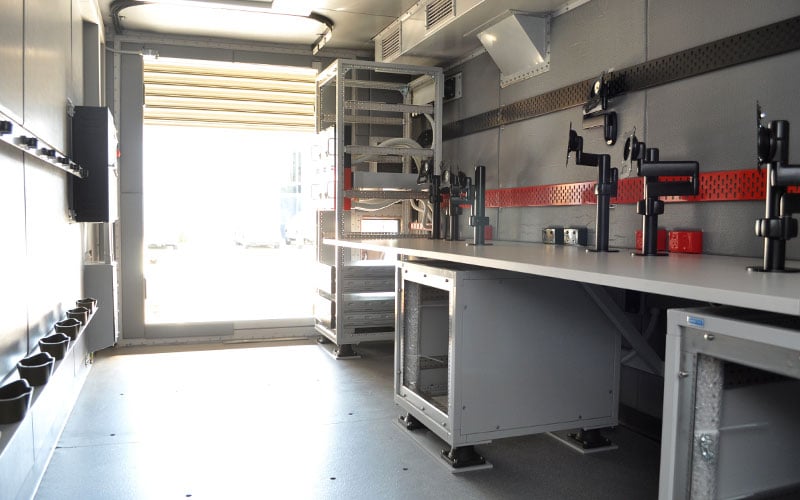
SAGE delivered the electrical elements of four mobile control and reporting centres (pictured) that will
allow the RAAF to maintain air control in overseas theatres.
There is a huge focus on building new capabilities and investing in the skills and technology needed for the future. I can say that with full confidence that SAGE is already ahead of the game in that area!
Is it important for a defence manufacturer to have experience across multiple sectors?
As we’ve already talked about, experience can be incredibly valuable for developing supplier relationships within the defence supply chain.
Something we have found at SAGE is that maturity in multiple areas has been a huge benefit in our ability to deliver a complete solution. We can provide a comprehensive and ongoing knowledge transfer, which is crucial for many of our manufacturing and service clients, and that includes the defence industry.
Particularly for Australia, where market access can be difficult because of our location, there is an opportunity for subject matter experts to make knowledge transfers part of a supply offering. There is an upswing in defence spending at the moment and a greater need for knowledge in some niche areas of the industry, but meeting the resource requirement is a challenge.
How important is it to have a discussion about ongoing support with a defence manufacturer?
This probably comes back to the long-term supply relationship we discussed earlier. Primes are looking for manufacturers who can provide through-life-support capabilities — this is hugely important. When equipment can remain in service for 20-30 years, local support needs to be available for that period of time.
With SAGE, for example, we have a multi-disciplinary service team that is highly sought after because we can step in and provide support for maintenance and operations. When needed, we’ve been able to draw in experts from around the nation to complete a job, like we did with the control systems onboard the HMAS Canberra.
What Industry 4.0 initiatives are you excited about for defence manufacturing?
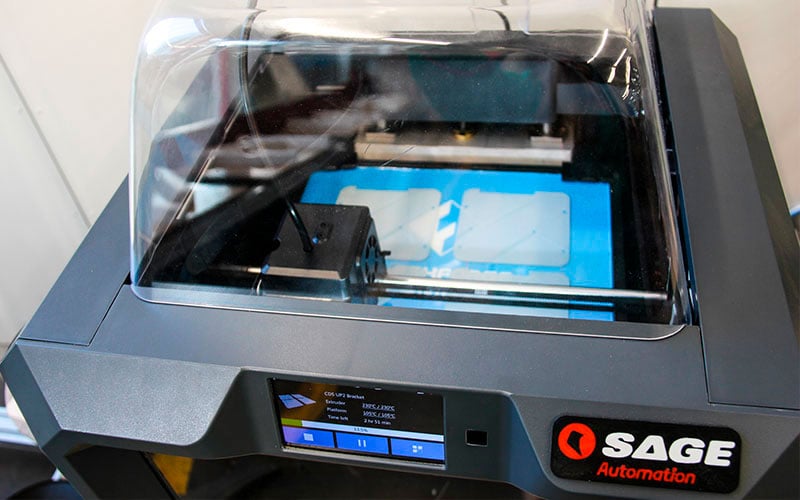
SAGE's 3D printer allows the company to do prototyping for rapid deployment of new ideas
I recently attended a conference and saw some interesting developments around intelligent remote support. This can really plug in to digital manufacturing to allow improved through-life-support for the supply chain.
Another huge area of value is 3D printing. The ability to 3D-print spare parts means defence manufacturers can simply print on demand instead of holding massive inventory — which allows them to be more competitive on price and lead times. As we touched on earlier, this is a great example of enabling speed to market and agility in manufacturing.
Building defence manufacturing partnerships
As the Australian defence industry looks to expand its capability in coming years, the growth in infrastructure, skills and expertise needed must start now. A strong, future-focused defence supply chain partner is essential for the projected growth plan.
SAGE’s agile and innovative approach to projects with defence primes, OEMs and SMEs has us well-positioned to deliver on your needs. See how we’re lowering costs and reducing asset risk for the supply chain:

